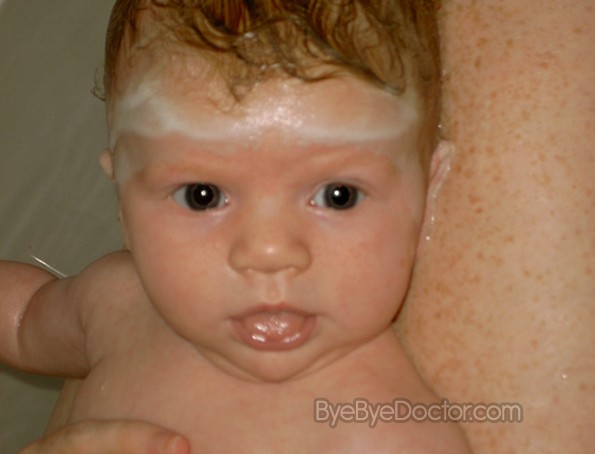What is Cradle Cap?
This is a fairly common disorder of the skin which normally affects the scalp creating itchy, scaly, red skin as well as persistent dandruff. Cradle cap is what this condition is called on infants.
Cradle cap of the scalp is not harmful, but can be unsightly and uncomfortable. Most frequently it develops in the first few months after delivery and normally clears up on its own in about 6 to 12 months – although in some cases the baby may have it for several years. It might be noticeable around the baby’s eyebrows or ear and even in armpits as well as other creases. When it is not in the scalp, this condition is called seborrheic dermatitis.
Cradle Cap Causes
Though the cause of cradle cap is not exactly known it is not caused by allergy, poor hygiene or infection. One contributing factor could be hormones which pass to the baby from the mother prior to birth. It is believed that these hormones produce an abnormal production of oil or sebum in the oil glands as well as the hair follicles. This sebum is a greasy substance which makes older cells of skin attach to the scalp as they try to dry and fall off.
Another factor could be a yeast or fungus called malassezia which grows in sebum along with other bacteria. Antifungal treatments for instance ketoconazole are at times effective, supporting the indication that a causative factor is yeast.
Cradle cap is really not a serious problem and is only temporary. It normally disappears by the time the infant is 6 to 12 months old but can in some cases continue for longer. Seborrhoeic dermatitis can then develop again when the child reaches puberty. A different type of dermatitis, which is known as “atopic dermatitis” or “infantile eczema”, also can progress as the cradle cap is improving. This atopic dermatitis normally lasts for a number of years and is a disorder which is very scratchy.
Cradle cap is not contagious. It may or may not itch. If it itches, excessive scratching of the area can cause additional inflammation as well as breaks in the skin might cause mild infections or bleeding.
http://www.Symptoms-Causes-treatment.blogspot.com detect diseases at an early stage symptoms, and find out the causes and treatments best suited.
Cradle Cap Treatment
While cradle cap is often a very minor situation that merely causes a little shedding on a baby’s scalp, certain infants can have more extensive cradle cap with heavy scaling that anguishes some parents.
When treatment is necessary, many experts normally recommend that home remedies are tried first. If extensive cases of cradle cap continue, the pediatrician may recommend other treatments, including:
Applying steroid lotion or cream, starting with an OTC steroid for instance Cortaid and then moving up to something such as Derma-Smoothe FS lotion for cases which are really tough, especially when the scalp around the scales is very irritated as well as red.
- Washing the child’s scalp and hair with an antiseborrheic or antidandruff for example Sebulex shampoo, Selsun Blue or T-Gel a few times each week.
- Prescribing an antibiotic for any secondary infections of the scalp.
- Using a topical or oral antifungal medication or antifungal shampoo
Here is also some other information you need to know:
- Once the baby’s cradle cap is treated, you probably need to take steps, such as continuing to use an antiseborrheic shampoo, in order to prevent it from returning.
- Some babies with cradle cap may as well have a rash behind their ears and in the crease of their neck, face, arms as well as diaper area, and at this time it is referred to as seborrheic dermatitis. Even though this rash may look like eczema, unlike eczema, it is normally not very itchy.
- Cradle cap is believed to be influenced by hormones from the mother during pregnancy which possibly can over stimulate the oil glands.
- Infants who have widespread seborrheic dermatitis as well as other symptoms, such as a failure to thrive as well as chronic diarrhea, could have other medical problems such as Leiner’s disease or Langerhans cell histiocytosis X.
- Other experts believe that cradle cap could be a mild yeast infection which is why oral or topical antifungal medications sometimes are used as treatments.
- Although most infants outgrow cradle cap by 1 year, some continue to have some scales until they are much older. It is usually much milder as well as harder to notice than when they were younger.
Cradle Cap Home Remedies
Most experts recommend that home remedies should be tried first before consulting the baby’s doctor. Some of these include:
- Frequently shampooing baby’s hair
- Using a soft brush to try and brush off the scales
- Rub a tiny amount of baby oil or mineral oil and then shampoo the oil off. Leaving the oil on too long could make the cradle cap worse
- Cooking oil can also be used to loosen up the flakes on the baby’s scalp and then lightly brush with a soft toothbrush. Any loosen scales can be removed by shampooing with regular baby shampoo. Leave the cooking oil on the scalp for about 15 minutes.
- Others have found lavender oil is good to remove some redness from the scalp.
- Steep a teabag made from one of any of these herbs: chamomile, burdock, meadow sweet, comfrey root or slippery elm bark in a bowl of hot water. After the tea cools use this solution to wash the baby’s scalp.
Cradle Cap Pictures





